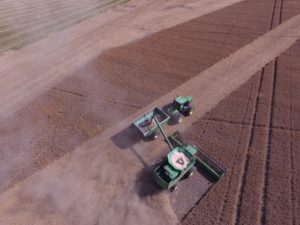Pre-Harvest Considerations
|
MATURITY
|
- Depending on type and variety, seeding date and seasonal moisture (drought to excess moisture), faba bean crops require a growing season of approximately 110 to 130 days.
- Colour change of the whole plant of 90% or greater is considered physiologically mature and ready for harvest.
- As faba bean matures, the lower leaves darken and drop, and bottom pods turn black and dry progressively up the stem.
- Time of maturity, crop height at maturity, and pod ripening can vary greatly from year to year.
- Late seeded fields will usually have increased days to maturity, decreased yield and slower pod ripening.
- Faba bean is sensitive and responsive to moisture, and thus swathing or baling is not recommended for faba beans.
- Closer to harvest, focus on lower pods where the majority of production comes from, instead of waiting too long for top pods to ripen.
- A faba bean crop can shatter as more pods are allowed to mature to the black stage or left standing until complete drydown; this is especially true if the crop is affected by drought or wind.
|
SEED MOISTURE CONTENT
|
- The crop is ready for harvesting at 18% to 20% seed moisture content if you have a clean sample and can aerate the seed.
- Seed should be aerated down to 16% moisture for safe storage.
- Dry for faba beans is <16% seed moisture content.
- Tough for faba beans is between 16.1% and 18% seed moisture content.
- Damp is >18% seed moisture content.
|
FIELD MONITORING
|
- Pre-harvest field monitoring will help determine which harvest system to consider, if more than one is available, and will greatly assist in determining when to begin harvest operations.
- Monitoring fields means checking plants in numerous locations for uniformity of stages of maturity.
- Most fields will not be 100% uniform in topography – there could be greener conditions in lower, wetter areas and further advanced plants on higher areas.
- A decision to begin harvest will hinge on a majority of the field meeting certain criteria. Do not sacrifice the quantity and quality of your crop waiting for smaller greener areas to reach the proper stage to start harvest.
- Harvesting too early will result in immature seeds.
- Harvesting too late when the pods are dry and brittle may result in shatter losses and will increase the risk of poorer quality seed due to adverse weather.
- The decision to start the harvest process will depend on three factors:
- crop maturity (stage of uniformity – how variable is the crop’s maturity?);
- seed moisture content; and
- presence of weed growth.
- Other considerations may include weather patterns, and marketing considerations.
|
PRESENCE OF WEED CONTROL
|
- Waiting for green weed growth to drydown will jeopardize quality and yields.
- Swathed green weeds are unlikely to dry sufficiently in a few days, so combining will be delayed.
- Green weed material in a straight-cut operation will cause extra wetness in the threshing areas of the combine, resulting in moisture on the seed coat and dirt adhering to this moisture (earth tag). Grades will be lowered because of earth tag (see Grading Section).
|
PRE-HARVEST AIDS (GLYPHOSATE)
|
- Various chemical harvest management tools are available to aid in the preparation for combining. It’s important to select the right product for the right crop and the intended outcome.
- Crop desiccation and drydown and pre-harvest perennial weed products are not the same. Make sure to select the right product, follow label directions, and timing of application. Harvest aid products vary in speed of activity, efficacy, and pre-harvest intervals.
- Apply glyphosate, a systemic herbicide, for pre-harvest weed control but not for desiccation. See Desiccation information further below.
- Glyphosate can be sprayed when the seed has less than 30% moisture content. At this stage, faba bean stems are green to brown, pods are yellow to brown, and 80% to 90% of the leaves have dropped.
- Timing your pre-harvest herbicide (glyphosate) can be a challenge. Applying glyphosate too early can reduce yield and seed size, and late-season application may result in levels of glyphosate in the seed that exceed maximum allowable levels.
- Glyphosate is registered for pre-harvest applications on faba beans and may be used to control perennial weeds such as quackgrass, Canada thistle, sow thistle, common milkweed, toadflax, and dandelion.
- This treatment will also stop late season chickpea regrowth, and some drydown. However, drydown is inconsistent and is unlikely to occur under cool, wet conditions.
- The crop and in-crop weeds must have enough green material remaining at application time for the herbicide to be effective.
- Glyphosate is not registered for crops destined for planting seed because irregular germination and seedling development can occur.
- Applying glyphosate too early can reduce yield and seed size, and late-season application may result in levels of glyphosate in the seed that exceed maximum allowable levels
- Growers must take appropriate risk mitigation steps to ensure product residues remain below maximum residue limits (MRLs) set by regulatory agencies.
- Prior to applying glyphosate check with potential buyers. Some companies are NOT accepting peas where glyphosate was used pre-harvest as weed control.
|
KEEP IT CLEAN
|
- Certain crop protection products can restrict the marketing options for your pulse crop. Before you make your crop management plans, talk to your grain buyer and read the Keep it Clean Pulse Maximum Residue Limits Advisory for a list of products of concern for this year, and the steps you can take to mitigate risk.
- More than 85% of Canada’s pulse production is exported to feed the world. Market access is important to the Canadian pulse industry, and growers play a key role in keeping the doors open.
- Source: For the latest “Keep it Clean” updates, visit Keep it Clean main website.
|

